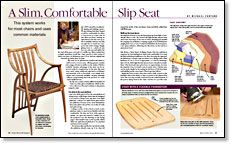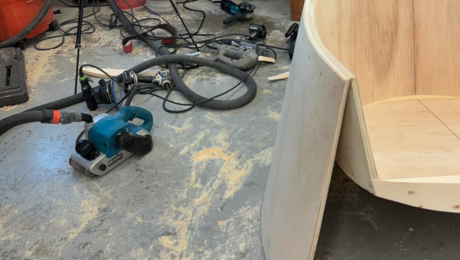A Slim, Comfortable Slip Seat
This system works for most chairs and uses common materials
Synopsis: Michael Fortune set out to design a dining-room chair that was graceful and stylish yet comfortable for hours at a time. His solution was an upholstered slip seat that can be easily replicated in most any shop. His approach involves four types of widely available foams and two layers of upholstery material. This technique, adaptable to other applications, resulted in a low-profile yet elegant and comfortable slip-seated chair that has lasted comfortably for almost a quarter-century.
From Fine Woodworking #163
In 1979 I spent five months designing and making a prototype dining chair that I hoped would be comfortable for three or four hours at a time. Part of that effort involved creating an upholstered seat that was up to this formidable task but was thin enough that it would not overpower the chair’s design.
Simply gluing foam to a plywood seat was not only uncomfortable but also had all the grace and style of a muffin top. What resulted was a simple upholstery detail that I have used in a wide variety of chairs ever since, in thicknesses up to 2-1⁄2 in. And my original seat has held up nicely these 24 years.
Slip seats are an upholstered, padded alternative to solid wood or woven seats, offering greater comfort and a range of looks as endless as the variety of fabrics available. Another advantage is that they can be removed easily for reupholstery. In the past, slip seats were made using traditional upholstery techniques and materials, such as horsehair. I use simple techniques and commonly available, modern materials without compromising the look and feel of a well-made traditional seat.
My slip seat consists of three different densities of foam on a thin plywood platform, which is slotted to allow it to flex and conform to the person using the chair.
I use 1⁄4-in.-thick plywood for the seat platform of dining chairs, while larger chairs that are designed to be used in a living room may have 1⁄2-in.-thick platforms. I always use Baltic-birch plywood for seat platforms because it has more laminations than other plywoods and the core is free of voids and quite strong.
Cutting a series of slots front to back on the platform makes it much more flexible and thus comfortable. The slots are 3⁄16 in. wide, approximately 2 in. apart and extend to within 2 in. of the perimeter. Then install T-nuts on the top side, which allow the upholstered platform to be attached and removed as needed.
For an inset slip seat like the one shown, the platform should come up 1⁄8 in. short all around the inside of the seat frame. Foam and fabric added later will fill the gap.
Moving from bottom to top, the foam layers go from high- to lowdensity (firm to soft). The closed-cell, high-density styrene foam used as the base layer of the seat is sold as sleeping-pad material for camping. It is available at camping-supply stores in thicknesses ranging from 1⁄4 in. to 3⁄4 in. To attach and laminate the foam pieces, I use spray adhesive, following the directions on the can for a permanent bond.
For the full article, download the PDF below.
Fine Woodworking Recommended Products

DeWalt 735X Planer

Ridgid R4331 Planer

AnchorSeal Log and Lumber End-Grain Sealer























Comments
“[Deleted]”
Log in or create an account to post a comment.
Sign up Log in